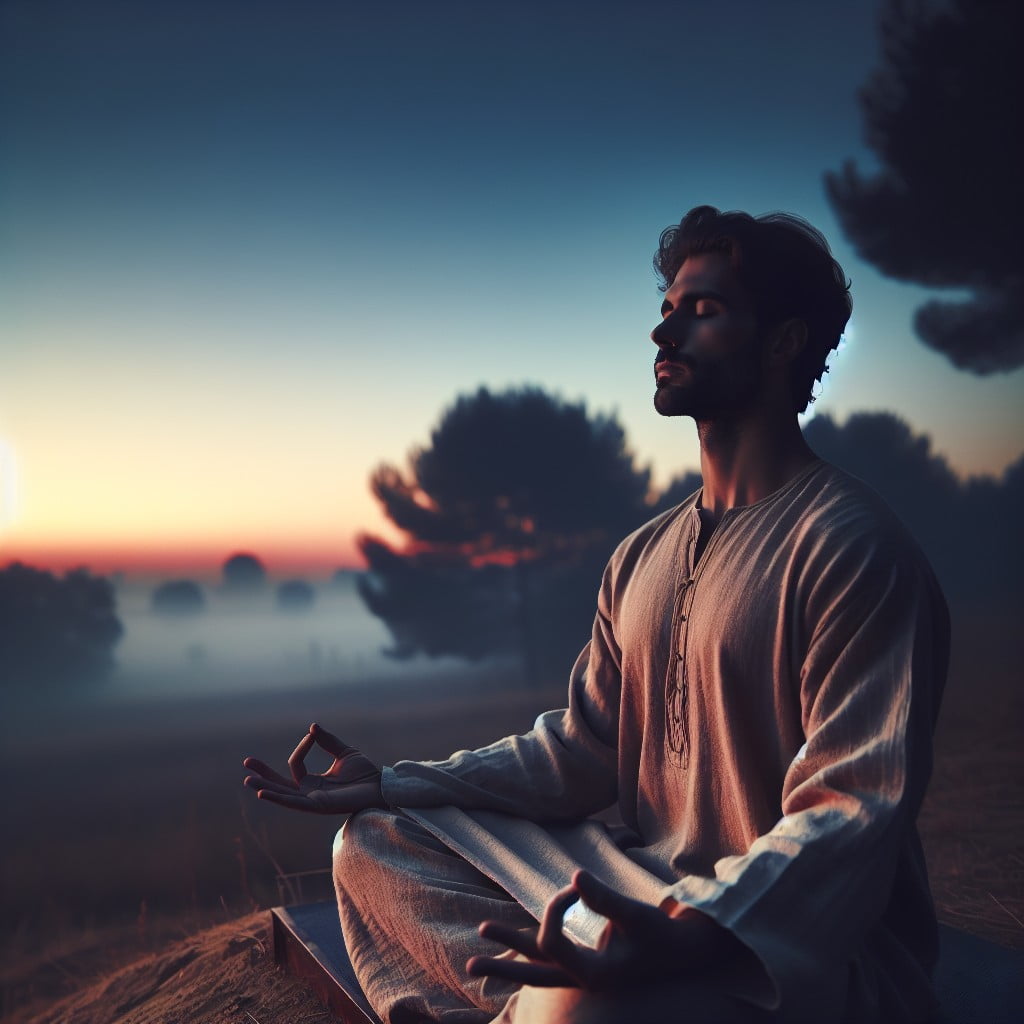Uncover the intriguing connection between meditation and cardinal directions because it has a profound impact on the quality of your mindfulness practice.
Meditation, a practice that transcends cultural and geographical boundaries, can be influenced by the direction you choose to face while meditating. While there isn’t a universally ‘best’ direction, many practitioners, particularly in Vedic traditions, suggest facing east or north due to the positive energy these directions are believed to offer. However, the key is to find a direction that promotes comfort, focus, and a sense of peace for you.
In this article, you’ll find a thorough exploration of the significance of each direction and tips to help you discover the optimal orientation for your meditation practice.
Key takeaways:
- North: Stability, grounding, patience, and endurance.
- East: Enlightenment, connection with the sun, enhances concentration.
- South: Physical strength, vitality, and health.
- West: Tranquility, contemplation, reflection, and self-compassion.
- Choose based on comfort, tradition, intuition, and intention.
Facing North During Meditation

Traditionally associated with the element of earth, the north direction is believed to bestow stability and groundedness. Meditating in this direction can help foster feelings of firmness and reduce restlessness. It is especially beneficial for those seeking to develop qualities such as patience, endurance, and consistency.
In terms of the body’s magnetic field, aligning oneself north promotes a calming, physical energy, excellent for establishing a deep sense of relaxation. Geomagnetic fields can subtly influence one’s meditative state, further enhancing the efficacy of the practice.
Renowned Chinese feng shui emphasizes the north as the direction of career growth and personal accomplishments, hence meditating while facing north often has been linked to increased focus and productivity.
On a practical note, those living in colder climates may find meditating facing north to be soothing due to the cooler energy flow associated with this direction. However, your personal comfort and preferences should always take precedence when selecting the optimal direction for meditation.
Facing East During Meditation

In many spiritual cultures, east is associated with enlightenment and awakening, making it a favored orientation during meditation practice. Here are a few key points that elucidate why.
1. Ancient wisdom: Traditions such as Vedic and Buddhist often regard the east as the direction where spiritual energy thrives. They believe meditating facing east aligns one’s energy with the cosmos, facilitating a deeper meditative state.
2. Connection with the sun: The east is where the sun rises. Symbolically, facing the east to meditate is like meeting the new day head-on, making it an ideal choice for morning meditation.
3. Enhances concentration: The cardinal direction helps in maintaining consistency and creating a meditative rhythm, which aids in focus and concentration.
Remember, it’s about what resonates with you. If you feel more aligned and centered while facing east, go ahead. Trust your intuition and make the practice your own.
Facing South During Meditation

When meditating towards the south, the physical body gets a vigorous energy boost. Discussions and studies around this concept often correlate it to the strong solar energy coming from this direction. These characteristics are ideal for those who seek more physical strength, wellbeing, vitality, and health.
Notably, improvements have been reported in the stabilization of body rhythms and functions such as sleep cycles and digestion.
If your meditation goals include greater physical well-being, embracing the southward orientation may indeed be beneficial. It’s not without reason that many yogic practitioners are known to prioritize this direction, especially in practices involving physical activity.
But keep in mind that each person may react differently, it’s always a matter of individual trials to find the perfect match.
Facing West During Meditation

When you sit facing West for your meditation session, you align yourself with the setting sun, symbolizing the close of the day and the ushering in of the calm evening. This direction is often associated with tranquility and contemplation, making it ideal for those seeking peaceful meditation sessions.
Moreover, it’s believed to offer a space for reflecting upon the day and releasing any accumulated stress. This alignment can facilitate a smoother transition into a restful, rejuvenating sleep, particularly if one meditates during sunset. The concept of water element is also tied to the West, symbolizing fluidity and emotion. Therefore, this orientation might assist in processing emotions and cultivating a deeper sense of self-compassion.
Finally, certain yogic traditions recommend this direction to those on a spiritual path, as it’s said to be conducive for self-realization and enlightenment. Nonetheless, personal comfort and experience should be decisive factors in your choice.
The Impact of Direction On Meditation Experience
Every person’s meditation experience varies greatly, influenced by a multitude of factors. One such element is direction. In certain cultural and spiritual traditions, the orientation during meditation is considered more than just a physical alignment. It’s believed to create a harmonious interplay between our energies and universal vibrations.
1. North is typically associated with calmness and tranquility. Meditating in this direction energies are balanced and stability is increased, helping to enhance focus and grounding.
2. Attuning oneself to the East relates to the sunrise. Orienting in this way welcomes the energetic attribute of illumination, sharpening clarity and wisdom.
3. Facing South is tied to the element of fire and symbolizes transformation. Meditating in this direction may ignite dynamism and zest, fueling personal growth and evolution.
4. Lastly, West is connected with water, relaxation, and introspection. Concentrating in this course can help with soothing and unwinding, promoting deep introspection.
Remember that the geographical orientation isn’t a rigid rule and what matters most is your comfort, peace, and the power of your intention. Any direction can serve as your personal compass towards mindfulness, as long as it resonates with you profoundly.
Scientific Basis Behind Directions in Meditation
Research has shown that the earth has a magnetic field that subtly influences the human biofield—i.e. the body’s electromagnetic field—paving the way for a distinct connection between us and our environment.
1. The Human Biofield: Our bodies are like magnets, with the head as the positive pole and the feet as the negative pole. When we align our body’s field with the earth’s magnetic field, it promotes a state of equilibrium.
2. Magnetic Influence: Different directions offer varying effects on the biofield. This is deeply rooted in the earth’s geomagnetic properties and the flow of cosmic energy.
3. Hemispheric Syncing: Sitting with the head facing magnetic north and feet towards the south aligns with Earth’s magnetic field, encouraging synchronization between the brain’s two hemispheres and promoting deep meditation.
4. Geomagnetic Flux: Geomagnetic flux is weaker in the north-south direction and stronger in the east-west direction. Experts believe that stronger flux can hinder calmness and tranquillity.
Keep in mind though, these scientific principles serve as guidance. It’s key to choose a direction that feels most comfortable and in tune with your practice.
Choosing the Right Direction for Your Meditation Practice
When selecting your ideal direction for meditation, remember, the best choice can vary based on personal preferences and beliefs. Here are a few guiding principles:
- Consider Your Tradition: If you adhere to a specific meditation tradition, align with its teachings. Some advocate for facing east, like in yoga, others might not stipulate a certain direction.
- Listen to Your Body: Use intuition as a guide. Reflect on how each direction feels during meditation. Over time, you may notice a certain orientation influences your focus or relaxation level.
- Experiment: If unsure, try out different orientations. Note your experiences, and see if patterns emerge.
- Reflect on Your Intent: If your practice is centered on growth or aspirations, considering facing east—the direction of the sunrise. To ground and stabilize, choose north, as it’s the Earth’s rotation axis.
- Respect your Environment: If in a room with a beautiful eastern view, meditating to this vista elicits peace, then the east might be perfect for you.
Ultimately, the right direction facilitates a deeper, more meaningful meditation experience. It’s all about finding what personally resonates best with you.
FAQ
Which direction should you face when meditating?
When meditating, you should ideally face the east or northeast according to Vastu Shastra, as this direction is believed to be where Earth's powerful magnetic energy is generated.
Which direction should you face for morning meditation?
You should face East for morning meditation to receive the subtle rays of wisdom that radiate westward over the earth.
Can we meditate facing south?
Yes, you can meditate facing south to receive healing energies.
Can we do meditation facing west?
Yes, meditation can be performed facing west, as the direction does not hinder the practice.
Is there a specific direction prescribed for evening meditation?
No, there is no specific direction prescribed for evening meditation.
How does the geography or location affect the preferred meditation direction?
Geography or location does not affect the preferred meditation direction, as meditation can be performed facing any direction.
Are there different orientations for solo versus group meditation?
Yes, solo meditation often focuses on personal awareness and self-regulation, while group meditation can lead to shared experiences and heightened collective consciousness.